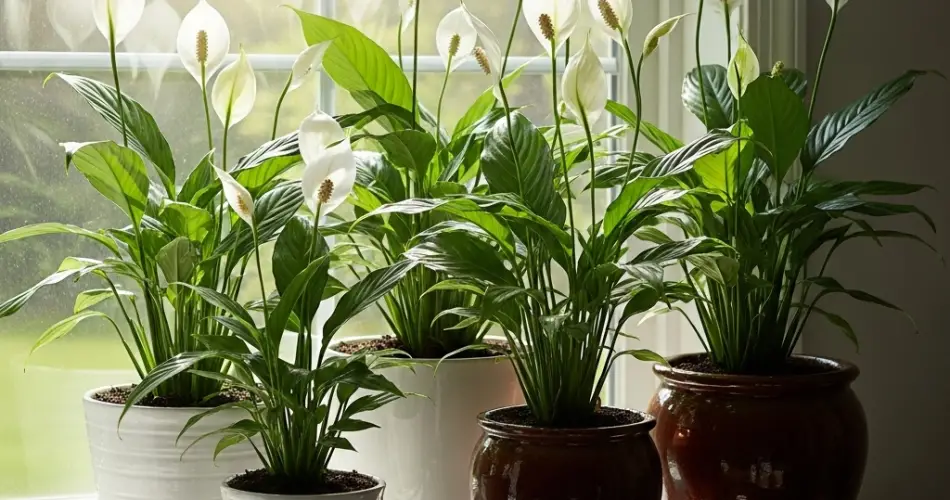The peace lily (Spathiphyllum spp.) is a beloved houseplant known for its elegant white blooms and rich, green foliage. While it’s often grown for its decorative beauty and air-purifying qualities, many people don’t realize that, with the right care, you can encourage your peace lily to bloom more frequently and with greater vigor—even in a container on a sunny windowsill.
If you’re wondering how to get the most out of this stunning plant, follow these expert tips to maximize its bloom yield and overall health.
Understanding the Peace Lily
Peace lilies are native to the tropical rainforests of Central and South America, where they thrive in warm, humid environments with dappled sunlight. Although they’re often marketed as low-light plants, they actually perform best and bloom more profusely in bright, indirect light.
That’s why a sunny windowsill—especially one facing east or north—is a perfect location, as long as the light is filtered or gentle.
The Right Light for More Blooms
While peace lilies tolerate low-light conditions, they need brighter light to produce abundant blooms. Place your peace lily near a sunny window, but shield it from harsh, direct sun with a sheer curtain or by positioning it slightly off to the side.
Direct sun, particularly during the afternoon, can scorch the leaves. On the other hand, insufficient light results in more foliage and fewer or no flowers. For year-round blooming, ensure the plant receives at least 6 hours of bright, indirect light daily.
Best Containers and Soil for Peace Lilies
To maximize flower production, you must start with the right container and soil. Use a pot with drainage holes to prevent waterlogging. Peace lilies don’t like sitting in soggy soil, as this can lead to root rot and hinder flowering.
The soil should be light and well-aerated. A good mix includes:
-
2 parts peat moss or coco coir
-
1 part perlite
-
1 part compost or leaf mold
This combination holds moisture while allowing excess water to drain, keeping the roots healthy and encouraging bloom development.
Smart Watering Practices
Peace lilies are sensitive to both overwatering and underwatering. For optimal performance, water when the top inch of soil feels dry. Insert your finger into the soil to check moisture levels before watering.
When you do water, saturate the soil thoroughly until water drains from the bottom, then discard any excess from the saucer. Reduce watering in cooler months, when growth slows.
Avoid letting the soil dry out completely for extended periods, as stress can delay or reduce blooming.
Humidity and Temperature Matter
Peace lilies flourish in warm, humid conditions. If your home is dry, especially in winter, consider these humidity-boosting techniques:
-
Mist the leaves lightly with water (but not the flowers).
-
Place the pot on a tray filled with pebbles and water (ensure the pot isn’t sitting directly in water).
-
Group your peace lily with other humidity-loving plants to create a microclimate.
-
Use a small humidifier nearby.
Maintain indoor temperatures between 18°C and 27°C (65°F–80°F) and avoid placing the plant near cold drafts, heating vents, or AC units.
Fertilizing for Flower Power
Peace lilies benefit from regular feeding when aiming for frequent blooming. Use a balanced liquid houseplant fertilizer (such as 20-20-20) diluted to half strength. Feed every 4–6 weeks during the growing season (spring through early fall).
Avoid overfertilizing, as it can lead to salt buildup and brown leaf tips. In winter, when the plant’s growth slows, pause fertilization to avoid stressing the roots.
Pruning and Repotting for Vigor
To encourage continuous blooming, remove spent flowers and any yellowing leaves. Cut the flower stalk at the base once the bloom fades. This redirects the plant’s energy to producing new growth and flowers.
Peace lilies prefer to be slightly root-bound, but if you notice roots growing out of the drainage holes or water runs right through the pot, it’s time to repot. Choose a container one size larger and refresh the soil. Repotting every 1–2 years in early spring can rejuvenate the plant and boost yield.
Common Blooming Problems
-
No flowers: Usually due to low light, lack of nutrients, or overcrowded roots.
-
Small or short-lived flowers: Often caused by stress from temperature fluctuations or dry air.
-
Brown flower tips: Typically from overfertilization or low humidity.
Addressing these issues with light, feeding, and humidity adjustments often restores the peace lily’s performance.
Final Thoughts
With the right combination of light, water, humidity, and nutrition, peace lilies can become one of the most rewarding flowering houseplants in your home. Even in a small apartment or limited space, a sunny windowsill offers just what the plant needs to thrive.
By creating ideal growing conditions and maintaining simple care habits, you can enjoy lush foliage and repeat blooms throughout the year—transforming your peaceful houseplant into a truly prolific performer.



